
Preparing Food
Karangasem, 1988. |
Acknowledgements
I would like to thank the people of Bali, strangers and friends alike, for their help. I would also like to thank my parents for their support and encouragement in making this work possible. |
Language
In an archipelago with thousands of inhabited islands and hundreds of separate languages, Indonesian was adopted as the national language in the late 1920's (two decades before Indonesia even existed as a sovereign nation), but it is the mother tongue of few Indonesians. The language has no declensions, conjugations, genders, or articles, and is relatively easy for Westerners to learn. I learned a little Indonesian prior to my first trip, and concentrated on becoming proficient during my first two trips. The traveler speaking just a little Indonesian is accorded a much warmer welcome. This work would not have been possible had I not learned about 2500 words of Indonesian. |
|
Balinese is a far more difficult language: there are three levels of Balinese, and the speaker chooses a level based on his relative social standing with the person being spoken to. Vocabulary, not structure, changes between the three levels. Very few Westerners speak Balinese. |
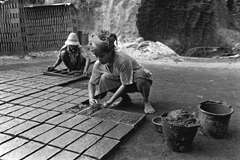
Brickmaking
Asak, Karangasem, 1988.
Until recently, mud, thatch, and coconut timber were the universal building materials in Bali. Bricks are made at the source of the clay, sun dried, and low-fired. The resulting brick is soft and weathers rapidly. |
Photographing Bali
I sought the least developed regions of Bali to photograph. I photographed mostly in the regency of Karangasem (in eastern Bali) because I know it best, and because it is less affected by Western influences. Until 1986, few tourists visited Karangasem, and the fruits of an improving economy were slow to appear in this impoverished region. I also photographed occasionally in the more remote parts of Klungkung, Bangli, Gianyar, Badung, and Buleleng. Some photographs were made in and around Ubud, in Gianyar, which has known tourism since the 1930's, but which has made a concerted effort to protect its cultural integrity. None of the photographs were made in the rapidly developing area around Denpasar. |
|
I worked often in Samuh, a small village abutting the Candi Dasa resort area, and most photographs in family compounds were taken there. My friend I Nyoman Mudra and brother I K'tut Suarta introduced me to many neighboring families. My photographs in other parts of Bali were mostly confined to relatively public scenes. |
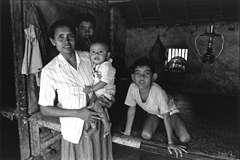
Family at Home
Samuh, 1988. |
Traditional life in Samuh had changed little as of 1989. This village is somewhat atypical. It is in a dry regions of Bali where no rice is grown. Its principal sources of income were coconut farming, lime burning, and fishing. Dependence upon the sea is not common--Bali turns away from the sea and towards the sacred mountains. The pattern of settlement in Samuh is also unusual. Houses and shops are usually clustered tightly along the road, but in Samuh houses are spread out among the coconut palms on one-hectare plots. However, the culture and people of Samuh seem similar to the rest Bali. |
|
Samuh is a poor village because most of the residents are tenant farmers who give the lion's share of their produce to the landlord. In wet years, corn is grown in Samuh. Bananas also grow in abundance, beneath the canopy of coconut palms. Viewed from the nearby hills, the village appears to be a vast coconut plantation; from this vantage point there are virtually no signs of human habitation. |
|
On my first photographic trip, my objectives were not well defined, and I returned with quite a few landscape photographs. However, after reviewing the work, I realized that the photographs I liked were photographs of people, and on subsequent trips I made no further landscape photographs. |
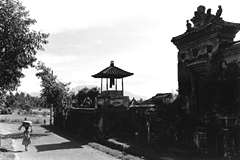
Temple
Budakling, 1985. |
When I first traveled in Karangasem in 1985, there were few power lines, and light in many villages still came from kerosene. By 1989, a vast electrification scheme was nearly in place, and much of the countryside is now draped with power lines. I have worked hard to keep them out of my photographs, but a few have cropped up here and there. |
| I also tried to keep motor vehicles out of my photographs. They have begun to play a significant role in the lives of all Balinese, even those who never themselves ride in one. The ubiquitous bemo (a sort of jitney) has brought economical public transportation and freight to all areas of Bali, and the array of goods available throughout Bali has greatly increased. Similarly, the use of trucks has eased some of the most back-breaking labor all across the island. However much traffic there may be during the day, most of Bali is quiet after dark. |
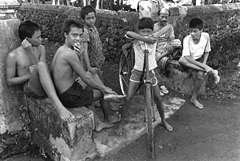
By the Road
Tabanan, 1989. |
My photographic excursions were usually facilitated by hiring a car and driver and wandering slowly through the countryside. Many photographs were therefore taken near, and sometimes on, the road, where much Balinese life occurs. In my quest to find parts of Bali where older ways predominated, we drove down every small road in Karangasem, where the old Bali can still be found, largely undisturbed. |
| There are more men than women represented in the photographs. This is the result of the greater public presence of men; women are more often at home than men. In addition, women and girls are often shy about being photographed. Many more females than males declined to be photographed. Often, when I came upon a claque of village children, they would all run: the girls to hide and the boys to crowd around the camera. While most men consented to be photographed, a great many women were embarrassed or refused outright. I noticed that when people were celebrating a festival they were much more willing to be photographed, perhaps because they were wearing their best clothes. I often noted a good deal of hurried clothes changing when I arrived at a family's home to photograph them. |
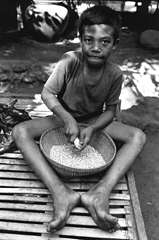
I Nengah Surata
Samuh, 1988. |
With scant exception, I gave no direction by speech or gesture to the people I was photographing. Occasionally when making family portraits, I suggested a location for the family to gather but did not attempt to arrange the group except sometimes to ask them to move closer together. |
| I made no direct attempt to shape subjects' reactions. However, I have no doubt that another photographer would evoke different reactions and produce different photographs. I believe that portraiture is the documentation of a relationship, however brief, between the photographer and his subjects. As can be seen in most of the photographs, my intrusion was a significant disruption of routine. Had I chosen to use telephoto lenses, I could quite easily have taken "candid" photographs, but this is not how I like to work. |
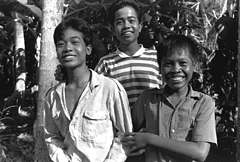
Three Brothers
Klungkung, 1989. |
I photographed only those who consented. In some cases, consent was only their spontaneous smiles as I pointed the camera at them, but in most cases I asked before I photographed. Quite a few people declined to be photographed. People in some villages seemed quite averse to being photographed whereas those in the next village might be willing, even eager, to be photographed. I found no pattern to this phenomenon. Occasionally people asked for money to pose for photographs. I always declined such requests because I felt that the resulting photographs would be stilted. I tried to give proof prints to my subjects when I returned. |
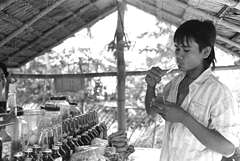
Smoking at the Warung
Eastern Karangasem, 1989. |
Chronology
Through a fortuitous circumstance in March 1985 I was able to travel around the world, and Bali was but one destination among a dozen. I arrived on 20 April 1985, planning to stay three weeks. I quickly fell in love with Bali and thoroughly enjoyed traveling the length and breadth of the island. Even my meager abilities with Indonesian allowed me some interesting and unusual experiences denied to other travelers. I enjoyed meeting the Balinese and found them a highly likable, friendly people. |
|
Quite by chance, on 9 May 1985 I met Ibu Gedong Bagoes Oka, who runs an ashram in Candi Dasa. She invited me to live in the ashram for a month and teach motorcycle mechanics, and I moved in the following day. A small group of young men and I began to overhaul bikes. In the process, we became fast friends. The core members of this group were I Kadek Nate, I Wayan Mastriyana, I Wayan Jata, and I Ketut Salin. The ashram was a beautiful place, and at the end of a hot day there was a refreshing swim in the sea. I worked on my Indonesian and steeped myself in Balinese life and culture. I came to realize that I was enchanted with the place. |
|
On 13 June I had to leave, and it was with great sadness that I parted from my new friends, promising to return. I continued with my trip, returning to the United States in mid-July. Although I enjoyed the remainder of my trip, Bali was never far from my mind. |
|
I returned to Bali on 2 October and went directly to the ashram, where I had a joyous reunion with my friends. I also met Stephanie Fried, a young American Fulbright scholar staying at the ashram. She taught me a great deal about Bali and helped me to see some of the difficulties underlying what sometimes seemed an idyllic life. During this trip I also got to know I Nyoman Mudra, a teenager living at the ashram, and helped him with his English. My second trip was not as gratifying as my first, as my purpose was hazy. I stayed at the ashram until 20 December 1985 and was again very sad to leave. |
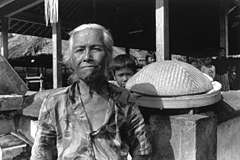
Near the Marketplace
Eastern Karangasem, 1988. |
Upon my return home I decided to take up photography again, a passion during my youth but since then largely ignored. I returned to Bali on 16 December 1986 intending to make a photographic record of Bali. I did not yet have a clear idea of what I wanted to say. Mudra was attending school in Amlapura, 13 kilometers away, but was home visiting his family on school holiday, during which he helped me with my photography. When he returned to school, I went to Ubud, the cultural heart of Bali, which seemed a good place to work. |
|
I was often at loose ends during this trip. I had not yet clarified my photographic purpose, and my friends were often busy with work of their own. I shuttled between Ubud and Candi Dasa with some regularity, making photographs in both places. I took quite a few landscapes, made many close-ups of people's faces, and photographed small groups of people in their daily routines. |
|
I returned home on 19 January 1987 and began to process the photographs. It became clear that, beautiful as Bali is, my feelings for Bali had to do with the Balinese, not their island. It also became clear that for me the important issue was the character of Balinese social relations. I resolved to concentrate on this during future trips. |
|
I again went to Bali on 12 June 1988. I based myself in Candi Dasa. Mudra was on vacation from school and thus free to assist me. With his help I set about photographing village life and social interaction, mostly in the villages within 25 kilometers of Candi Dasa. Typically, we would leave after breakfast and drive through nearby villages until lunch, by which time it was too hot to photograph productively. I returned to the U.S. on 6 July, and was generally pleased with the results of the trip. |
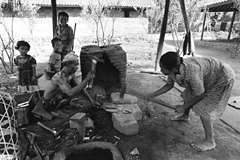
Family Forge
Jungsri, 1987. |
On 9 June 1989 I arrived in Bali for the final sojourn in my work. This trip was very much like the preceding one, except that I shot almost twice as much film. My photography was even more tightly concentrated in Karangasem than before. When I left Bali on 19 July 1989, I did not know whether and when I would return to Bali. Six years have now passed. Bali is often in my thoughts, and some day I shall return. But other things keep me busy now, and I have postponed several planned trips. Perhaps I am a little scared to see what has become of my beloved island and its wonderful people. |
|
Availability of Prints
Signed, first-edition fine-art prints are still available for most of the images shown here, and others as well. Shipment can be arranged from either the U.S. or The Netherlands. |
|
Publisher Sought
I am seeking a publisher to produce a paper edition of this work. |

Harvesting Thatch
Near Gunung Seraya, 1988. |
Technical Notes
Two Nikon F-3 HP cameras and one or another of the following Nikkor lenses were used: 35mm f/2, 28mm f/2, 24mm f/2.8, and 20mm f/2.8. An 85mm f/2 was carried on the first trip and a 105mm f/2.5 on the second, but these lenses were so little used that I carried only wide-angle lenses on the third trip. An MD-4 motor drive was used on one body during the second and third trips. I experienced a shutter failure early on the first trip and a problem with fungus on lens elements on the third trip but otherwise had no technical difficulties. Further growth of fungus was inhibited by storing the equipment in a covered bucket when not in use. The equipment was wrapped in newspaper and the bucket heated with a five watt lamp burning continuously. This is a common method in Bali and seems to work by preventing condensation during wet spells. The ink vapor in newsprint may help to prevent growth, so fresh newsprint should be used. |
|
I exposed 38 rolls of Tri-X at E.I. 400 on the first trip. This film was developed in Edwal FG-7 to relatively high contrast. |

Preparing for the Galungan Feast
Tegallinggah, 1988. |
On the second trip, 48 rolls of Tri-X were exposed at E.I. 400 and developed in Agfa Rodinal, again to relatively high contrast. In addition, nine rolls of TMax P-3200 were exposed at E.I. 3200. This film was developed in TMax developer, and although some good images resulted, they were extremely difficult to print because of very poor shadow detail. Film consumption increased significantly with the use of the motor drive. |
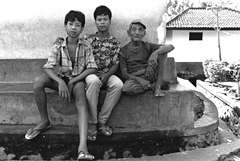
Young and Old
Eastern Karangasem, 1989. |
On the third trip I shot 86 rolls of TMax 400 at E.I. 320 and 10 rolls of TMax P-3200 at E.I. 1250. The TMax 400 was developed in Acufine, giving quite good film speed, moderate grain, and good sharpness. The TMax P-3200 was again developed in TMax developer; rating the film at E.I. 1250 resulted in greatly improved shadow detail. While at the time I found the Tmax to be a slightly better film than the Tri-X, I find that I miss the characteristics of the Tri-X and might revert to its use in the future. |
|
Negatives from the first trip were printed on Ilford Galerie. Negatives from the second and third trips were printed on Ilford Multigrade Fiber Base. Prints are all on 11x14" and were processed in accordance with Ilford's quick-fix archival processing recommendations and toned in Kodak Rapid Selenium Toner. |
|
Virtually all prints required manipulation, sometimes extensive, to yield pleasing tonal values; manipulation was limited to contrast adjustment, dodging, and burning. Most prints were made on grades 1½ through 2½. All prints were made from the full frame of the original negative. |
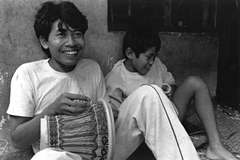
Making Lampshades
Bukit Badung, 1989. |
Although Bali is located near the equator and is bathed in intense tropical sunlight, most photographs were taken in relatively low light. No supplementary illumination was used. Excepting a relatively small number of photographs made in full sunlight, most photographs were made at exposures ranging between 1/125th at f/8 and 1/30th at f/2.8. |
| I was assisted in making the large majority of the photographs by Mudra or his younger brother K'tut. Their assistance saved me the bother of carrying my own gear and also helped to secure the consent of those I wished to photograph. |
|
Bibliography |
|
Alexander, Christopher, A Pattern Language, New York: Oxford University Press, 1977.
|
|
Critchfield, Richard, Villages, Garden City, New York: Anchor Press/Doubleday, 1981.
|
|
Daniel, Ana, Bali: Behind the Mask, New York: Alfred A. Knopf, 1981.
|
|
Geertz, Clifford, Negara: The Theatre State in Nineteenth-Century Bali, Princeton: Princeton University Press, 1980.
|
|
McPhee, Colin, A House in Bali, New York: The John Day Company, 1946.
|

Four Boys with a Fighting Cock
Samuh, 1989. |
|



